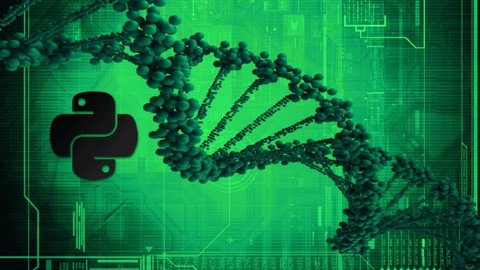
Introduction to programming for Bioinformatics with Python
Introduction to programming for Bioinformatics with Python, available at Free, has an average rating of 4.39, with 28 lectures, 8 quizzes, based on 358 reviews, and has 12394 subscribers.
You will learn about Understand Bioinformatics Concepts Manipulate DNA and protein sequences Build your first computer program Develop scripts in the Python programming language Biopython Library This course is ideal for individuals who are Any student who wants to learn about programming for bioinformatics It is particularly useful for Any student who wants to learn about programming for bioinformatics.
Enroll now: Introduction to programming for Bioinformatics with Python
Summary
Title: Introduction to programming for Bioinformatics with Python
Price: Free
Average Rating: 4.39
Number of Lectures: 28
Number of Quizzes: 8
Number of Published Lectures: 28
Number of Published Quizzes: 8
Number of Curriculum Items: 36
Number of Published Curriculum Objects: 36
Original Price: Free
Quality Status: approved
Status: Live
What You Will Learn
- Understand Bioinformatics Concepts
- Manipulate DNA and protein sequences
- Build your first computer program
- Develop scripts in the Python programming language
- Biopython Library
Who Should Attend
- Any student who wants to learn about programming for bioinformatics
Target Audiences
- Any student who wants to learn about programming for bioinformatics
Welcome to the “Introduction to Programming for Bioinformatics with Python” course. Recently, the new sequencing technologies have allowed new discoveries for Life Sciences. However, computer skills became highly necessary to deal with big biological data. Hence, knowing how to build computer programs is essential to Bioinformatics.
In this course, you will learn the basics of programming for developing computer programs applied for Bioinformatics. You will also learn about creating your first algorithms, creating pipelines using the programming language Python, and analyzing biological databases. Python is the main programming language used for bioinformaticians.
This course is ideal for students who are starting in the field of bioinformatics and who do not have previous knowledge of programming.
You will also learn in this course:
• What are computer programs?
• How to create your first scripts?
• What is Python?
• Using the Colab web tool
• What are variables?
• Objects in Python
• Logical operators
• Variable types: strings, integers, Boolean
• Sequences in Python: lists, dictionaries, and tuples
• What are conditional statements?
• What are iterative statements?
• How to compare sequences
• Bioinformatics file types
• What is a software library?
• What is Biopython?
• How to convert a sequence from a string into a Biopython object?
• Manipulating sequences using Biopython
• Translation and transcription using Biopython
Course Curriculum
Chapter 1: Introduction
Lecture 1: Welcome
Lecture 2: Meet the Course Instructor
Lecture 3: A brief introduction to Bioinformatics
Lecture 4: Why would you need to know programming for Bioinformatics?
Chapter 2: Python fundamentals
Lecture 1: What will you learn in this chapter?
Lecture 2: Introduction to Python
Lecture 3: Colab tool
Lecture 4: Comments
Lecture 5: Variables
Lecture 6: Python Reserved Word List
Lecture 7: Arithmetic Operators
Lecture 8: Objects
Lecture 9: Strings
Lecture 10: Comparison Operators
Lecture 11: Logical Operators
Lecture 12: What is the if statement?
Lecture 13: If statement
Lecture 14: Loops
Lecture 15: The while statement
Lecture 16: The for statement
Chapter 3: Intermediate Level Python
Lecture 1: Lists
Lecture 2: Dictionaries
Lecture 3: Files
Lecture 4: Functions
Chapter 4: Biopython
Lecture 1: Introduction to Biopython library
Lecture 2: GC content
Lecture 3: Counting nucleotides
Lecture 4: Transcription and translation
Instructors
-
Diego Mariano, Ph.D.
Cientista de Dados e Doutor em Bioinformática
Rating Distribution
- 1 stars: 3 votes
- 2 stars: 18 votes
- 3 stars: 62 votes
- 4 stars: 121 votes
- 5 stars: 154 votes
Frequently Asked Questions
How long do I have access to the course materials?
You can view and review the lecture materials indefinitely, like an on-demand channel.
Can I take my courses with me wherever I go?
Definitely! If you have an internet connection, courses on Udemy are available on any device at any time. If you don’t have an internet connection, some instructors also let their students download course lectures. That’s up to the instructor though, so make sure you get on their good side!
You may also like
- Top 10 Video Editing Courses to Learn in November 2024
- Top 10 Music Production Courses to Learn in November 2024
- Top 10 Animation Courses to Learn in November 2024
- Top 10 Digital Illustration Courses to Learn in November 2024
- Top 10 Renewable Energy Courses to Learn in November 2024
- Top 10 Sustainable Living Courses to Learn in November 2024
- Top 10 Ethical AI Courses to Learn in November 2024
- Top 10 Cybersecurity Fundamentals Courses to Learn in November 2024
- Top 10 Smart Home Technology Courses to Learn in November 2024
- Top 10 Holistic Health Courses to Learn in November 2024
- Top 10 Nutrition And Diet Planning Courses to Learn in November 2024
- Top 10 Yoga Instruction Courses to Learn in November 2024
- Top 10 Stress Management Courses to Learn in November 2024
- Top 10 Mindfulness Meditation Courses to Learn in November 2024
- Top 10 Life Coaching Courses to Learn in November 2024
- Top 10 Career Development Courses to Learn in November 2024
- Top 10 Relationship Building Courses to Learn in November 2024
- Top 10 Parenting Skills Courses to Learn in November 2024
- Top 10 Home Improvement Courses to Learn in November 2024
- Top 10 Gardening Courses to Learn in November 2024






















